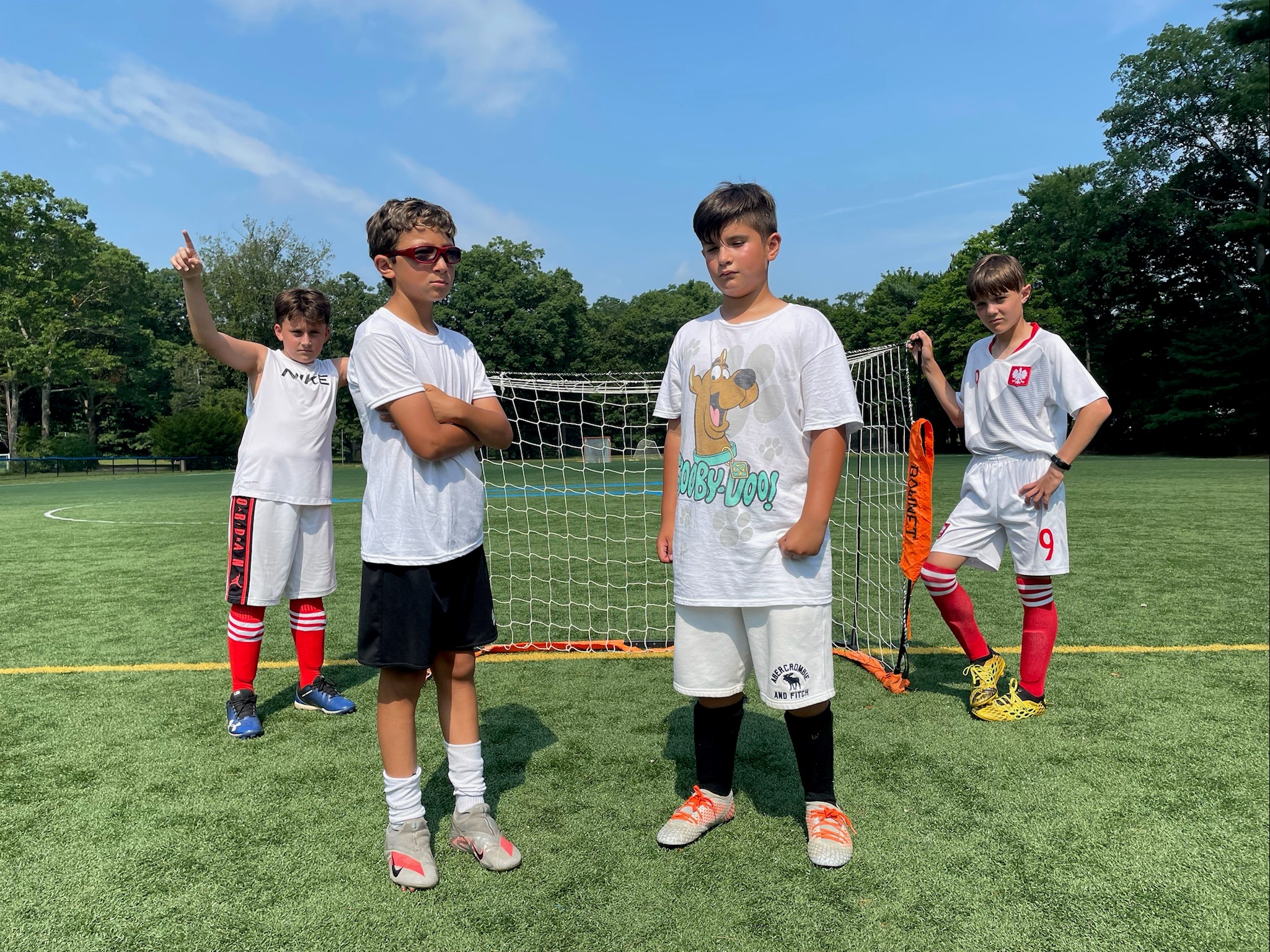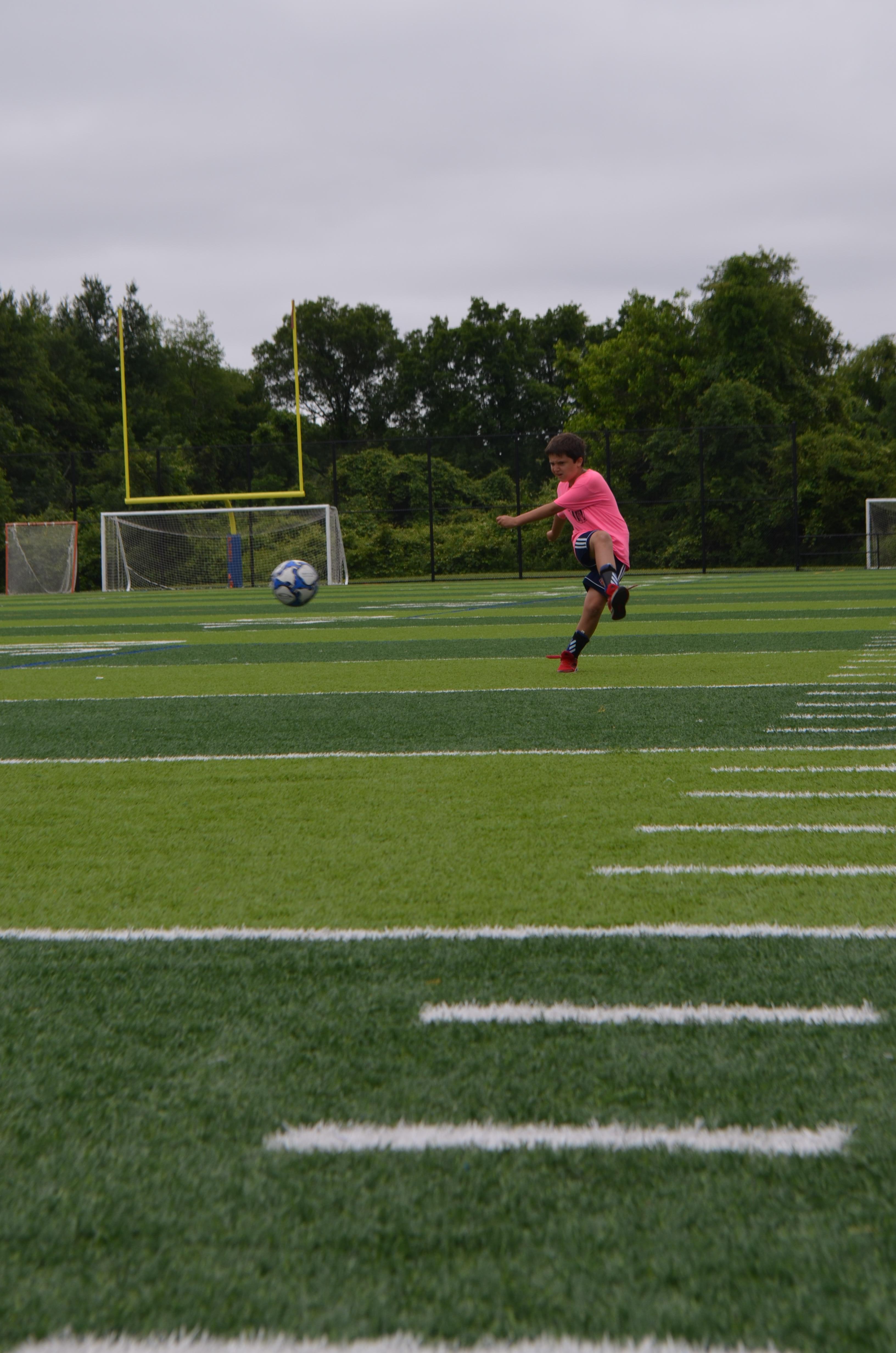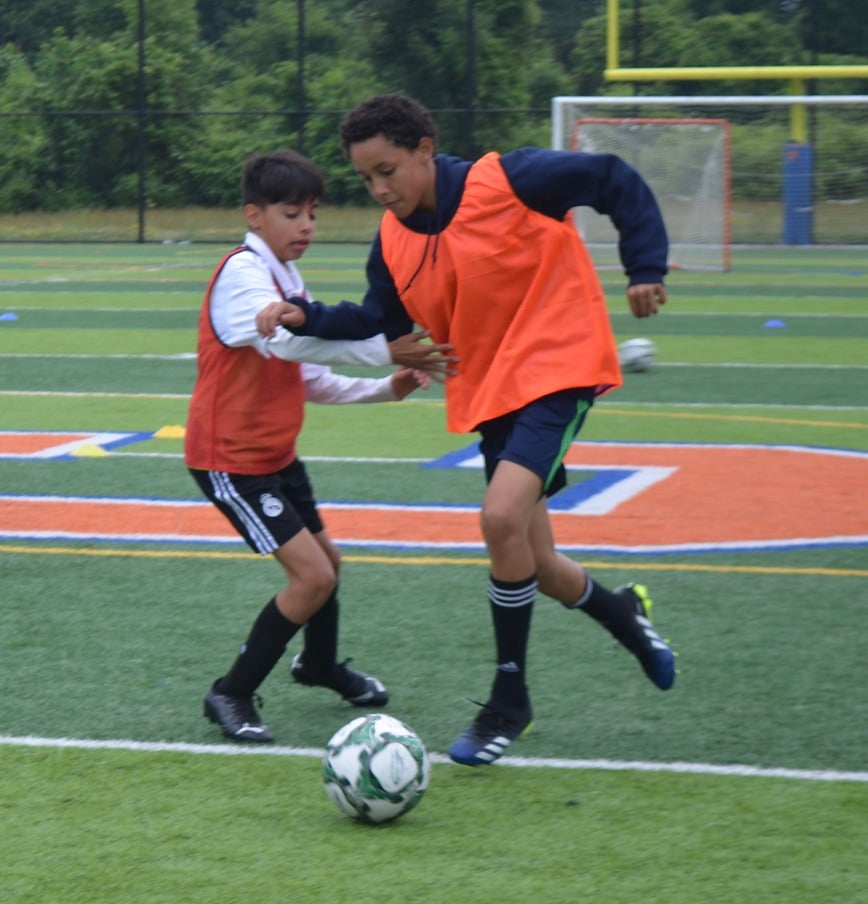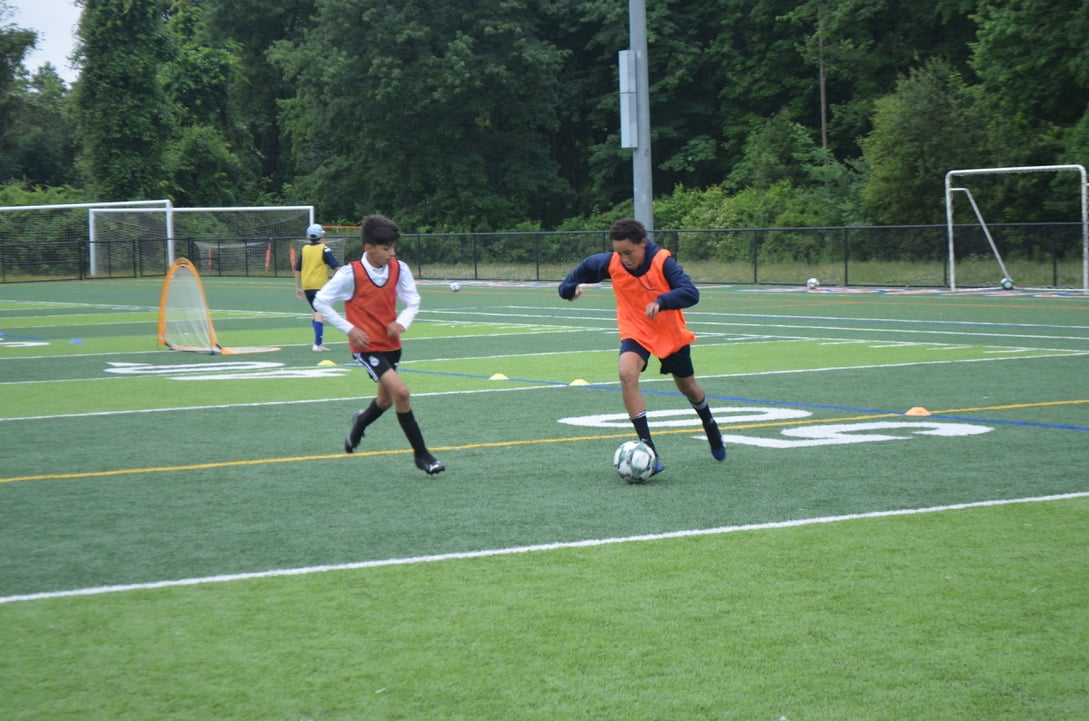There’s a reason why soccer is the most popular sport in the world!
For children, it opens up a world of fun, friendship, and fitness, offering them a chance to develop their physical abilities, such as improving coordination, balance, spatial awareness, and essential life skills like teamwork, discipline, and perseverance.

As parents and coaches, one of our greatest joys is watching our kids fall in love with the sport, learning to navigate its challenges and celebrate its triumphs.
But how do we ensure that this exploration of soccer is as enriching and enjoyable as possible?
It all starts with honing their skills.
Below is a list of soccer skills, drills, and tips to help your child succeed in soccer.
Basic Soccer Skills and Moves For Kids
Soccer involves many different skills to succeed — from shooting to playing effective defense.
Let’s look at all of them and how we can improve.
Shooting the Ball
Mastering shooting is essential for scoring goals, requiring precision, power, and technique.
- Power - Training to shoot hard focuses on building leg strength and practicing the correct technique for striking the ball with force. Exercises include shooting from a distance and practicing with a moving ball to simulate game conditions.
- Accuracy - Players need to be able to target specific areas of the goal, using targets or marked areas to improve shot precision. Players can practice shooting from various angles and situations to develop their ability to find the back of the net under pressure.
- Volleys and half-volleys - To master these techniques, players practice striking the ball out of the air, focusing on timing and body positioning.
-
Free kicks - Specialized training for free kicks involves practicing curve and dip shots around a wall of defenders. This includes setting up barriers to replicate match scenarios, allowing players to develop their skill in bending the ball past obstacles.

Chipping the Ball
Chipping is a finesse skill useful for lofting the ball over defenders and goalkeepers. It requires precise touch and timing.
- Lob shots - Players practice chipping the ball into the net over obstacles or from a distance, focusing on the technique of striking the ball's bottom to achieve loft.
- Chip passes - Chip passes over short and medium distances allow players to quickly lift the ball over an opponent's leg or into a teammate's path in crowded areas.
- Goalkeeper chips - Specifically targeting situations where goalkeepers are off their line, players practice chipping shots into the goal from various angles and distances, mastering the timing and touch needed to execute this skill effectively in games.
- Pressure situations - Incorporating defenders in drills to simulate match pressure, forcing players to decide when the chip shot is the most effective option and execute under pressure.
Dribbling and Ball Handling
Dribbling skills enable players to navigate through defenses, maintaining possession and creating opportunities.
- Close control - The ability to handle the ball in tight quarters is a must. Keeping the ball close to the feet during movement, enhancing control, and maneuverability with defenders close by are all important skills!
- Speed dribbling - Focusing on pushing the ball forward at speed without losing control at their maximum pace helps when game time comes around.
- Evasive maneuvers - Moves like step-overs, feints, and changes of direction to evade defenders are all evasive maneuvers that are crucial in the thick of the game.
- Protecting the ball - This skill helps tight spaces, allowing more plays to open up.

Passing the Ball
Passing is a vital component of soccer that facilitates team movement, maintains possession, and dismantles opposition defenses. Mastery of different passing techniques allows a team to control the game's tempo and create scoring opportunities.
- Short pass - The most fundamental passing technique, the short pass, is used for maintaining possession and building attacks from the back. It involves a gentle touch, usually with the inside of the foot, aimed at accurately moving the ball between close teammates.
- Long pass - The long pass is employed to quickly transition the ball over longer distances, often switching play or catching the opposing defense off-guard. It requires a stronger strike, typically with the laces or instep, directed towards a distant teammate.
- Through pass - A through pass is designed to penetrate the defense, leading a teammate into open space or towards the goal. Precision and timing are critical, as the pass must bypass defenders while remaining within reach of an advancing teammate.
Footwork
Improving quickness, balance, and coordination is essential for soccer players to effectively maneuver around opponents and execute precise movements on the field. Here are several exercises designed to enhance these vital attributes:
- Quickness and agility - The speed at which a player can change direction, accelerate, and decelerate is pivotal in soccer. Quick footwork allows players to navigate through tight defenses, create space for themselves and their teammates, and react swiftly to the dynamic nature of the game.
- Balance and stability - A well-developed sense of balance enables players to maintain control of their bodies and the ball, especially under pressure from opponents.
- Coordination and ball control - Effective soccer footwork requires a high degree of coordination, allowing players to synchronize their movements with the ball, teammates, and opponents.
- Explosive power and speed - Plyometric drills build the explosive power necessary for sudden bursts of speed, enabling players to beat opponents to the ball or space.
- Anticipation and reaction time - Refined footwork skills greatly enhance the ability to anticipate an opponent's next move and react accordingly.

Defensive Soccer Skills
Effective defending is critical to a team's success, requiring physical ability, tactical knowledge, and mental sharpness. Here's a closer look at the fundamentals of defending:
- Positioning - Proper positioning is the cornerstone of effective defense. It allows players to intercept passes, block shots, and challenge opponents more effectively.
- Tackling - Mastering the art of tackling involves timing, technique, and decision-making.
Reading the game - The ability to anticipate and react to the opponent's actions is vital for defenders. - Aerial duels - Winning aerial battles is a vital skill for defenders, especially in set-piece situations. Exercises aim to improve jumping technique, timing, and the ability to use the body effectively.
- Recovery runs - Teaching defenders to make quick recovery runs when possession is lost is essential for preventing counter-attacks.
Goalie Skills
Goalkeepers play a pivotal role in a soccer team's defense, requiring a unique set of skills to effectively protect the goal. Specific training focused on enhancing shot-stopping abilities, mastering the art of diving, and commanding the penalty area can significantly improve a goalkeeper's performance.
- Shot-stopping - This fundamental skill requires goalkeepers to have quick reflexes and the ability to predict the ball's path.
- Diving - Proper diving technique is essential for reaching shots outside the goalkeeper's immediate grasp.
- Commanding the penalty area - A goalkeeper must be able to command their area, making decisive actions to intercept crosses and communicate effectively with defenders.
- Distribution - Beyond stopping shots, goalkeepers must also be skilled in distributing the ball to start attacks.
- Positioning and footwork - Good positioning allows goalkeepers to cover the goal effectively and make saves easier.
Fun Soccer Drills For Kids
How can we work on many of these skills in a fun and engaging way?
It’s simple: Going through fun soccer drills!
These games and drills help improve soccer skills in various areas of the game while also being fun to play.
Here are some drills to get you started.
Passing Drills
Passing in Pairs
- Players pair up and stand approximately 10-20 yards apart, focusing on accurate ground passes to each other's feet.
- Once players are more adept at passing, you can increase the distance for longer passes, use only two touches, or limit to one touch as players improve.
- This drill helps develop accuracy in short and long passes and improve first-touch control — fundamental skills for soccer players!
Triangle Passing
- Another simple drill: all you need to do is set up three players in a triangle formation, about 15-20 yards apart. Players pass the ball to each other in a clockwise or counterclockwise direction, moving to another point of the triangle after passing.
- Triangle passing enhances communication, timing, and understanding of passing angles. When the game starts, these are crucial skills in crunch time.
Keep Away
- Most people remember playing keep away on the playground! This drill involves players forming a circle around 2-3 defenders in the middle. The outer players pass the ball to keep it away from the defenders.
- To make it more difficult, limit touches or expand/reduce the circle size based on skill level.
- Playing keep away helps improve passing under pressure, spatial awareness, and teamwork.
Pass and Move
- Players form a line at one end of the field. The first player in line passes the ball to a coach or another player at the other end and then runs to the end of the receiving line. This continues in a fluid motion with each player.
- Passing to players who are standing still is one thing, but players need to know how to pass on the move. This drill helps players understand movement after passing, encouraging them to think ahead and position themselves effectively.
Shooting Drills
One-Time Shooting
- Players line up and pass the ball to a feeder near the edge of the penalty box. The feeder lays the ball off for the players to one-time the ball.
- The one-timer is a must-have in any player's shooting arsenal. This drill improves players' ability to shoot accurately without needing to control the ball first, simulating match conditions where quick shots are required!
Pressure Shooting
- Players dribble towards the goal from different angles and distances while a defender applies light pressure. After shooting, the attacking player must then defend, transitioning into a new attacker coming in.
- This drill also simulates game-like conditions, improving shooting under pressure and defensive transition. When the pressure’s on, this drill can help!
Shooting From a Dribble
- Set up a course of cones for players to dribble through before reaching a designated shooting area. Once at the shooting area, players take a shot at the goal.
- Learning how to shoot on the move is a crucial skill. This drill enhances control and precision in shots taken after a dribble, improving players' ability to maintain composure and accuracy under pressure.
Free Kick Practice
- Players take turns shooting at the goal from various free-kick positions around the penalty area. To simulate a defensive wall, use a wall of mannequins or volunteers.
- Free kicks are an essential part of a player’s game. This drill develops accuracy and technique in free-kick situations, focusing on bending, dipping, or driving shots around or over the wall.
Dribbling Drills
Cone Dribble Course
- Set up a series of cones in a line or zigzag pattern. Players dribble through the cones using both feet and various parts of the foot (inside, outside, sole).
- Note: You can set up the cones in any formation you want — not just zigzag!
- The cone dribble course can improve close ball control, agility, and maneuverability in tight spaces.
1 vs. 1 With a Defender
- In a defined space, an attacker tries to dribble past a defender to score by crossing an end line. Rotate roles to give everyone the opportunity to dribble and defend.
- Looking to improve dribbling under pressure and defensive evasion techniques? The 1 vs. 1 drill is perfect for you!
Dribble and Stop
- Players dribble at full speed towards a line or marker before stopping the ball dead with the sole of their foot on command. This drill can be varied by changing the stopping technique to use different parts of the foot.
- This drill helps develop control over the ball at speed and enhances stopping precision under momentum. In a real game, these are essential techniques!
Red Light, Green Light
- Players start at one end of the field with a ball. The coach calls out "green light" (dribble forward), "yellow light" (slow dribble), and "red light" (stop and control the ball). The first player to reach the opposite end wins.
- This drill helps focus on ball control at different speeds and quick reaction to verbal commands, mirroring the unpredictability of match situations.
Tips To Help Your Child Get Better at Soccer
Improving in soccer is a journey that involves dedication, learning, and a lot of practice. Here are some practical tips to help your child enhance their soccer skills and enjoy the beautiful game even more.
Practice, Practice, Practice
Regular, focused practice is crucial for improvement in soccer.
Encourage your child to spend time each day working on their skills, whether dribbling, shooting, or passing. Consistency is critical to developing muscle memory and improving overall game performance.
Watching Soccer Matches
Watching professional soccer matches can be incredibly educational and inspiring. Encourage your child to observe the positioning, tactics, and individual skills of top players.
This can help them understand the game better and develop a deeper appreciation for soccer strategies.
Playing Pickup Games With Friends
Informal play with friends provides a stress-free environment for practicing soccer skills and enjoying the game. Pickup games encourage creativity, adaptability, and decision-making while fostering a love for soccer and building social connections.
Joining School Teams or Clubs
Participating in school teams or local soccer clubs offers structured training environments and the chance to experience competitive play. These settings provide valuable lessons in teamwork, discipline, and match play, contributing significantly to a player's development.
Attending a Summer Soccer Camp
Soccer camps offer an excellent opportunity for focused skill development in a fun and supportive environment.
These camps often provide intensive training sessions, experienced coaching, and the chance to play with and learn from other soccer enthusiasts, making them a valuable experience for any young player looking to improve.
Future Stars, for example, offers exciting soccer camps at several of our locations throughout the Long Island and Westchester, including:










.png)
.png)
.png)
.png)